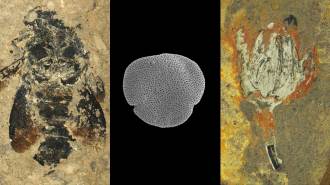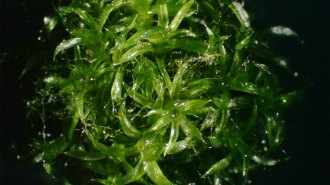A carnivorous water plant with tiny traplike bladders dotting its leaves may not deserve its reputation as a relentless predator, says a Florida scientist.

A survey of bladderwort plants in the Everglades found far more bladders harboring living organisms than dead ones, reports Jennifer H. Richards of Florida International University in Miami. Although the plant does kill insect larvae, it offers a safe home for smaller organisms, which may pay rent in nutrients. The bladderwort, or Utricularia purpurea, “is not like a bear trap,” she says, but more like a terrarium.
A mature bladder has a built-in trap door that operates on a hair trigger. When the plant pumps some water out of the bladder, the door can snap inward if an insect larva or even a bit of debris brushes it. The ensuing inward rush of water draws anything nearby into the bladder. A few keen-hearing naturalists have reported tiny pops from door openings.
Earlier work in other laboratories had shown that the bladders absorb nutrients from their catch. To study feeding in the wild, Richards monitored and sampled plants from several Everglades locations. The species ranges from the tropics to Canada.
With a microscope, Richards categorized contents of about 1,400 pinhead-size bladders. Immature bladders were empty, but virtually all the mature ones held photosynthetic microbes, such as algae. Microscopic animals called rotifers showed up in 20 percent of the bladders. All the tiny occupants seemed alive and well, Richards reports in the January American Journal of Botany.
In contrast, the insect larvae and other larger creatures found in 6 percent of the bladders were dead. Richards says that although the bladders do absorb nutrients from prey, it’s unlikely that the rare prey could repay more than a whisker of the resources that the plant invests in its bladders. On average, the plants dedicate about a quarter of their biomass to bladders, Richards calculates.
The bladder tenants might offer the plant valuable carbon dioxide, Richards speculates. In other aquatic plants, she says, a shortage of carbon dioxide limits growth. She speculates that the bladders’ microinhabitants collectively boost the plant’s supply. She suspects that miniature ecosystems inside the bladders also yield other nutrients the plant can absorb.
Robert Ulanowicz of the Chesapeake Biological Laboratory in Solomons, Md., has made computer models of bladderwort growth. He questions Richards’ idea of a mutualism between the plant and its bladder dwellers. “It remains unclear how the captured organisms would benefit,” he says.
The new paper reminds Thomas Miller of Florida State University in Tallahassee of his own work on Sarracenia purpurea, a carnivorous plant with pitcher-shaped leaves. Despite their reputation as omnivorous death traps, these plants don’t secrete any flesh-eating enzymes within their traps, Miller notes. In fact, several insect larvae survive only inside the pitchers. The plant, in turn, absorbs nutrients shed by the larvae.
Richards now chuckles that she herself once sensationalized the lifestyle of Utricularia, the genus that includes 42 percent of the world’s carnivorous plants. “I was a believer,” she deadpans, recalling her early plan to analyze the bloodthirsty predator. “Then, I studied it.”






